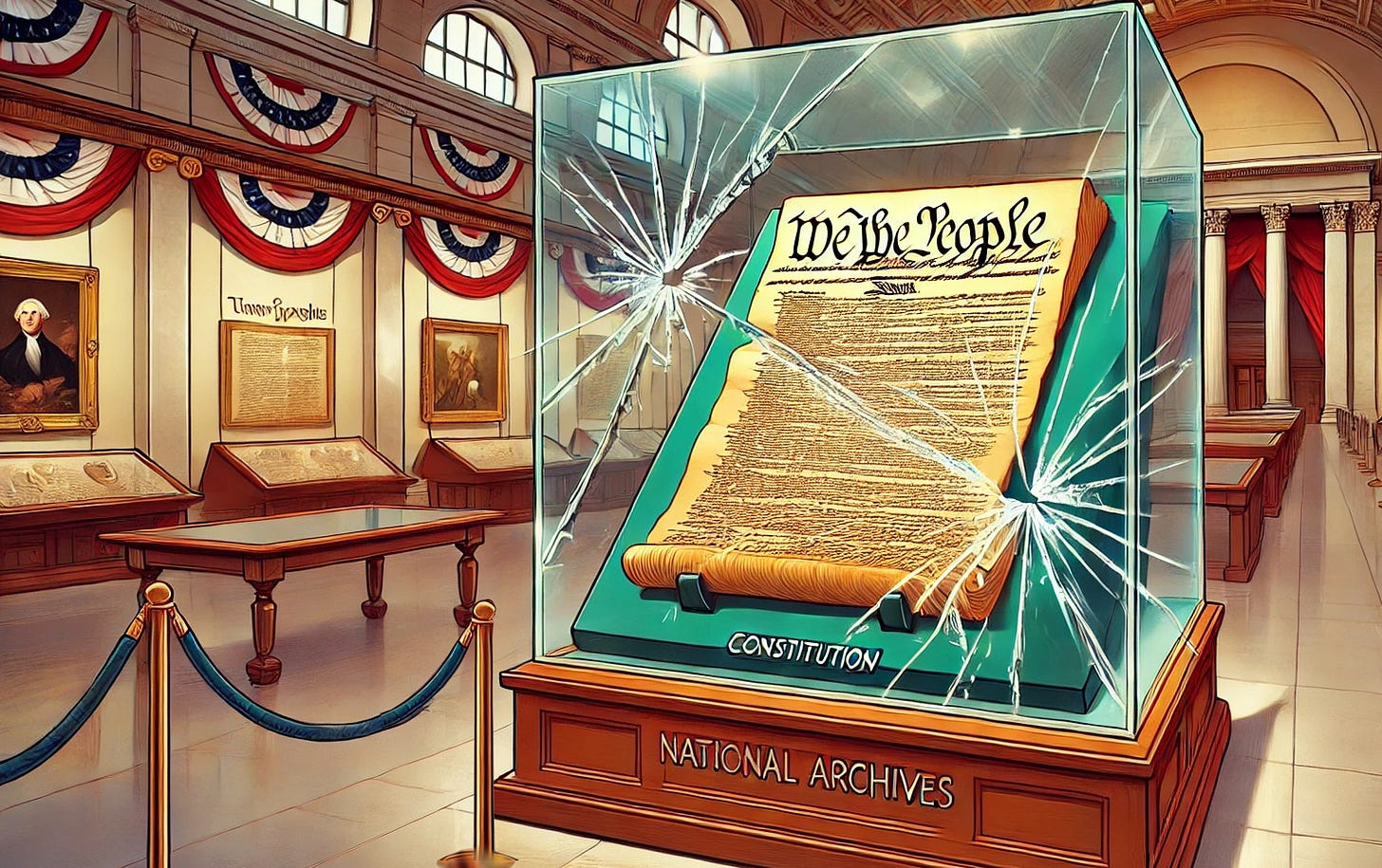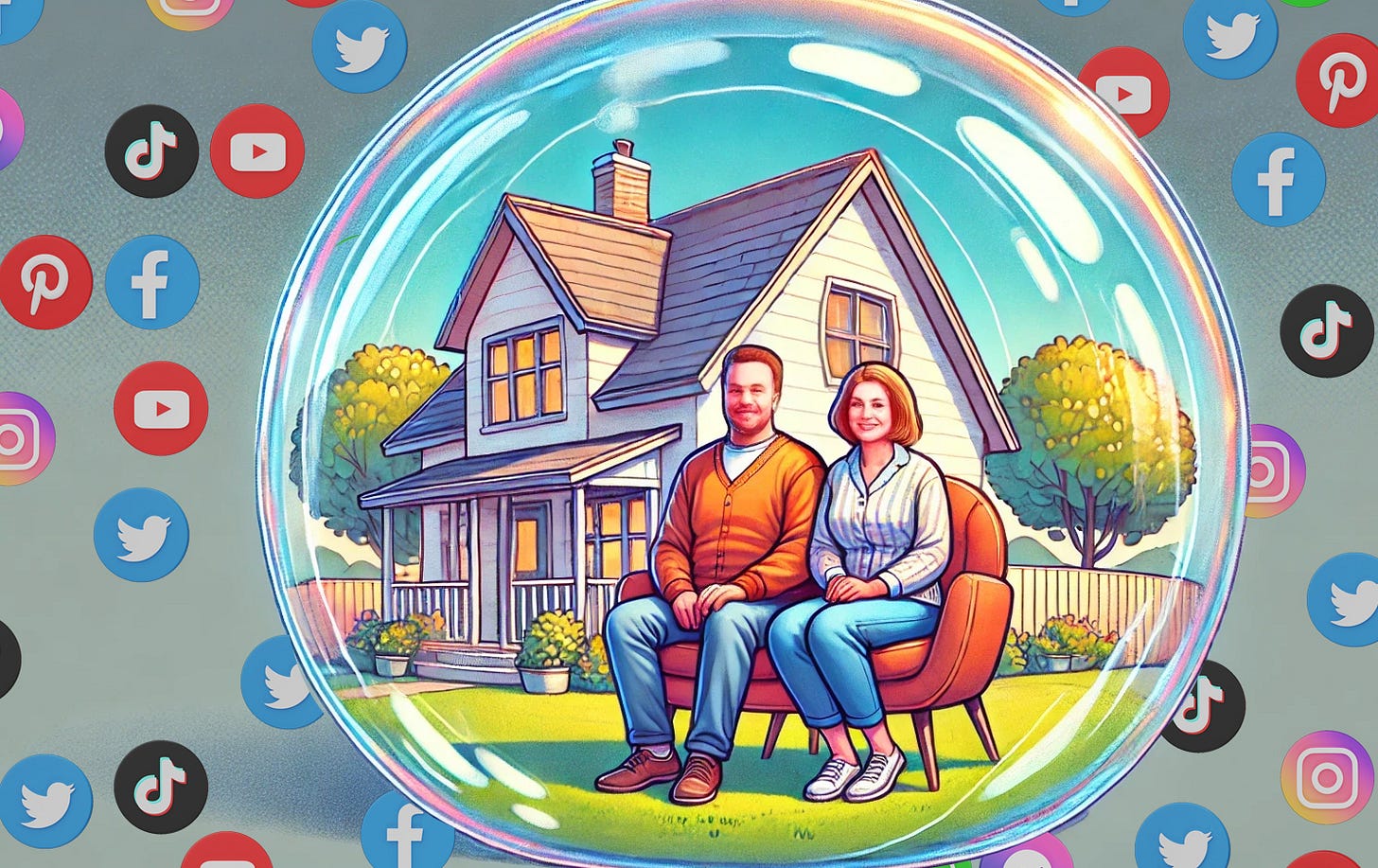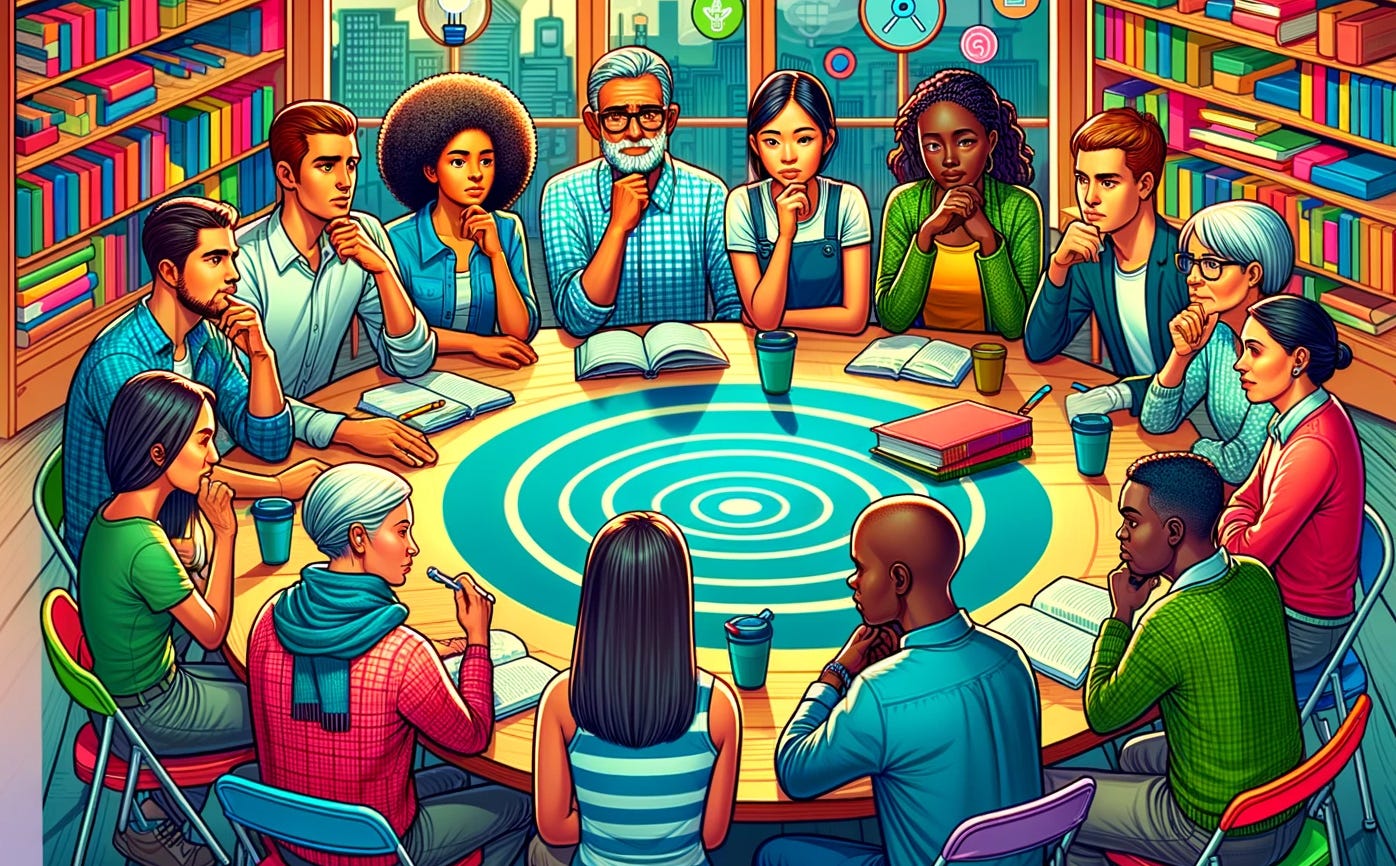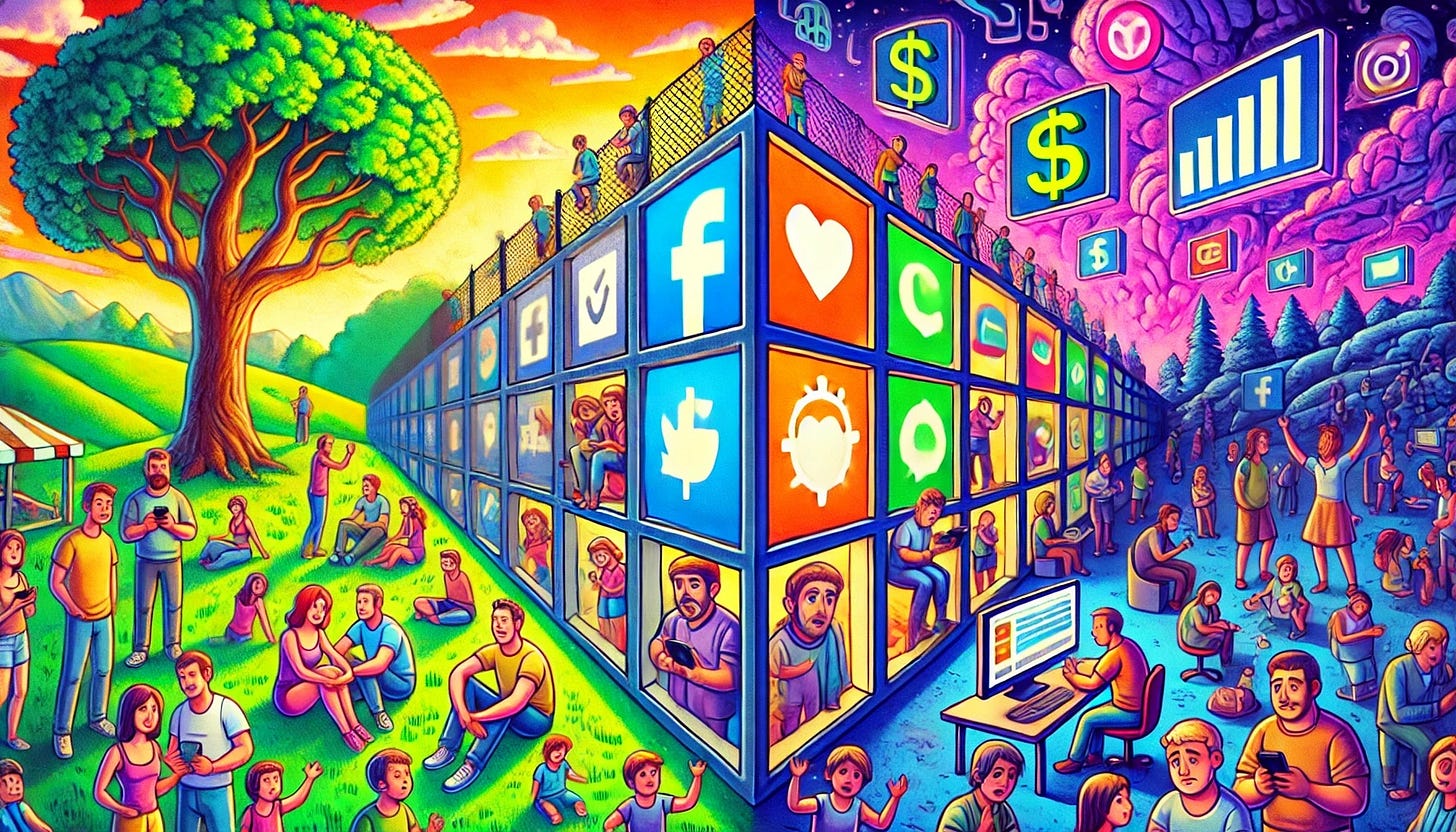PPPPressure Points (Four Ps #249)
Critical Thinking, Filter Bubbles, Failures & Distractions, and New Social: Navigating This Turning Point
These past two weeks, I hit the pause button ⏸️, but only because I couldn't hit rewind ⏸️⏪.
I haven’t turned on the TV 🚫📺 or clicked a news link 🚫🔗 in nearly two weeks.
Not because I don’t care—quite the opposite. But sometimes, when the world spins out of control, you’ve got to stop, breathe, and make sense of it all.
The election results were a punch to the gut. A turning point that’s impossible to ignore, but hard to fully process.
Last time out, on Election Day, I wrote about grief. Today? I’m standing at another crossroads:
Do I take a break from The Four Ps?
Trim it down to Three Ps and avoid politics?
Or shut it all down indefinitely?🤐
But ignoring isn’t an option. That’s not who I am. It’s not what we need.
🔄 Ready or Not... Here we go again. Four Ps, still standing.
Let’s unpack the Political, the Personal, the Practical, and the Professional—together.
THE POLITICAL: Trials and Errors of Experimentation
The election of Donald Trump as the 47th President of the United States has reignited intense debates about the nation's democratic foundations and the resilience of its republican structure.
Some of these debates are accurate. Much of them, however, are rooted in miseducation or based on misinformation. Shocking, I know.
At the heart of these discussions lies the distinction between a democracy and a republic, concepts that trace back to the Enlightenment, the American Revolution, and even Ancient Greece. Are we all clear on the definitions? Because one look at Twitter would suggest otherwise.
Democracy vs. Republic:
A democracy is a system where the power to govern is vested directly in the people, often exercised through majority rule.
A republic is a form of government where the people elect representatives to make decisions on their behalf, operating under a framework of laws designed to protect individual rights and prevent the tyranny of the majority.
The United States embodies a blend of both, often referred to as a democratic republic, where democratic processes are conducted within a republican framework. It was an experiment, a never-before-seen creation of government forged by wealthy, educated, white men:
The American Experiment (as Thomas Jefferson coined it in the Declaration of Independence) reflects the founders’ endeavor to create a government that balanced liberty and order, drawing from historical lessons to avoid the pitfalls of pure democracies and monarchies.
James Madison, in Federalist No. 10, warned of the dangers of factions and the potential for majority rule to infringe upon minority rights, advocating for a large republic to mitigate these risks.
But in the name of compromise, many concessions were made: Federal vs. states. Big states vs. small states. Slave states vs. free states.
The riotous events of January 6, 2021, when a mob stormed the Capitol, marked a significant challenge to American governance, and proved Madison right yet again. At the time, it drew parallels to the nation’s most tumultuous periods. But they’ve now been largely ignored, or worse, they’ve been validated.
The Constitution got a lot right. It also got a lot wrong. It was built to evolve, but it’s only been amended 17 times since it was ratified (not counting the Bill of Rights). However, that’s not ultimately why our experiment is failing.
While concerns have been raised about President Trump’s cabinet nominations and policy directions, it’s essential to recognize that (to date), these actions have occurred within the legal frameworks established by the Constitution. The Constitution provides a system of checks and balances designed to prevent any single branch from gaining unchecked power.
However, with a Republican majority in Congress and a conservative-leaning Supreme Court, the effectiveness of these checks is under scrutiny. Too many people don’t vote. Too many people don’t care. Too many people refuse to consult multiple sources of information. Social media has accelerated the spread of misinformation, and so on. But none of these alone are fatal flaws.
And now this country, as a democratic republic, faces its biggest test since 1865. So how do we check this imbalance?
It’s up to the states. States’ rights emerge as a crucial counterbalance. Blue states, in particular, may serve as bulwarks against federal overreach, leveraging their authority to implement policies that reflect their constituents’ values. This dynamic underscores the federalist structure of the United States, where power is shared between national and state governments, allowing for a diversity of approaches within a unified nation. It’s the last remaining defense.
As the nation navigates this complex political landscape, concerns about the erosion of democratic norms and the potential for authoritarianism have led to a pervasive sense of unease.
Expect it to feel worse before it gets better, a period of uncertainty and vigilance (but hopefully not violence). This serves as a reminder of the importance of active engagement: protest, freedom of assembly, petitioning the government, using the press, and working towards the next electoral cycle.
That is, if the democratic process, and the principles upon which the republic was founded, remain intact in two and four years.
THE PERSONAL: Getting Beyond the Bubble
I’ve spent the past few years deliberately marinating in the comfort of my own political filter bubble. And I've loved it.
Until about two weeks ago, I was with my people — where everyone agrees, my beliefs feel validated, and the other side’s arguments bounce off like poorly aimed darts. It was cozy in there.
The air smelled like smug satisfaction, and I could blissfully ignore opinions that make my blood pressure spike.
But here’s the catch: filter bubbles are sneaky little echo chambers.
I am not sure I ever even called it a filter bubble until last week, when I read a great piece by Kevin Indig, who pointed out that how they make you feel connected to reality, when in fact, you’re only connected to your version of it.
And let’s be honest, my version has been curated with the precision of a Michelin-starred chef.
The Pros of Staying in My Bubble? For starters, it was peace of mind. Smart people. Caring people. Factual news. Trusted sources. Friends. Family. Safety. security.
Who wouldn’t want to scroll through a feed filled with people nodding in agreement?
It’s like living in a perpetual group hug. Plus, I save a ton of energy by not engaging in Twitter brawls over who’s ruining the country.
The Cons? Well, it turns out my bubble warped my expectations. I'm not sure my disappointment or current anxieties would be any less severe than they are now, but at least I would have been prepared for a possibility -- and now a reality -- that has felt more painful than the death of a loved on.
I was convinced. I was confident my side would sweep the floor. Spoiler alert—it did not. My bubble whispered sweet nothings, and I believed them. Reality? A little harsher. A lot messier.
The Dilemma: So now that the bubble has burst, there are two options. Build a new bubble, like the previous one. Or do I venture into the wildlands of opposing views?
It sounds terrifying. Like willingly walking into a debate where “fake news” is thrown around like bags of cocaine inside Don Jr. Penn dorm room. But maybe—just maybe—it’s time. Because growth doesn’t happen in an echo chamber, and the world’s not as black-and-white as my bubble wants me to believe.
So here I stand, staring at the edges of my comfort zone. Will I step out? Who knows. But one thing’s clear: it’s going to be uncomfortable, awkward, and probably requires any and all of us who do so to build up a key skill: critical thinking.
THE PRACTICAL: Critical Thinking is Our Best Bet
Trust in institutions is crumbling. Mass media? Tainted. Government? Corrupt. Big business? Self-serving. 🧠
But before we spiral into hopelessness, there’s a light at the end of the tunnel: Critical Thinking.
This isn’t just about surviving the chaos, misinformation, or manipulation; it’s about thriving in it. Sharpening your mental toolkit is no longer optional—it’s essential.
Critical Thinking isn’t some abstract, academic exercise. It’s a practical skill that helps you separate fact from fiction, truth from propaganda. It’s like training for a sport or learning an instrument: the more you practice, the better you get at navigating life’s complexities. Starting today, let’s hone this critical skill. How?
1. Practice Makes Progress
Good thinking doesn’t happen by accident. It’s a deliberate process. Ever made a choice you regret? (We’ve all been there.) Critical Thinking helps minimize those moments by improving how you approach decisions.
Start by becoming aware of your own thought patterns. Our brains love shortcuts, but those shortcuts often lead to flawed conclusions. Identify the assumptions behind your beliefs. For example:
Why do you trust certain news sources but not others?
Why do you align with certain opinions?
Questioning your own thinking can reveal biases you didn’t even know you had.
2. Cultivate Intellectual Virtues
Critical Thinking isn’t just about analyzing facts—it’s about adopting a mindset that values truth over comfort. This means building a set of intellectual virtues to guide your thinking:
Intellectual Humility: Recognize the limits of your knowledge. Nobody knows everything, and that’s okay.
Courage: Engage with ideas that challenge your worldview, even when it’s uncomfortable.
Empathy: Truly understand others’ perspectives. Don’t just hear their words—grasp the reasoning behind them.
Integrity: Hold yourself to the same high standards you expect from others. Admit when you’re wrong.
Perseverance: Tackle tough questions with patience and determination. Good thinking takes time.
Autonomy: Think for yourself, even when it means going against the crowd.
These virtues are interconnected. Together, they create a mindset that’s resilient, adaptable, and fair.
3. Break Free from Groupthink
From the moment we’re born, we’re shaped by social environments—family, community, culture. While this helps us fit in, it also blinds us to perspectives outside our group. This is sociocentric thinking in action: the belief that “our” way of thinking is the only correct way.
In today’s divided world, the “good guys (and girls)” feel like they’re in the minority because sociocentric thinking fuels division. Political partisanship, cultural clashes, and even family disagreements often boil down to this: people entrenched in their group’s worldview, unable to see beyond it.
So what do we do?
Seek out views that challenge your own. Read books, articles, or listen to podcasts that make you uncomfortable.
Pay attention to how media frames stories. Look for loaded language or biased perspectives.
Engage in cross-cultural experiences to broaden your worldview.
By actively questioning group norms and biases, you’ll start to see the bigger picture. It requires deliberate practice and the conscious cultivation of intellectual virtues. By examining your own thought processes, challenging your biases, and striving for fairness and clarity, you’ll not only make better decisions—you’ll also contribute to a more thoughtful, compassionate society.
In a world where everything feels tainted, a clear mind is your most powerful weapon. Start now, and by the time we gear up for 2026 mid-terms, you’ll see the world—and your role in it—through a sharper, more discerning lens.
THE PROFESSIONAL: Rebuilding Our Social Networks—and Our Social Networks
When I helped build some of the first social media platforms as marketing tools, the vision was simple: create spaces for connection, collaboration, and community. Back then, we believed in the power of organic relationships and open dialogue. Fast forward to today, and those early ideals feel like a distant dream.
Social platforms have morphed into pay-to-play media empires— fragmented walled gardens where user data is currency and algorithms dictate what we see. They’ve become less about fostering real connections and more about manipulating messages to maximize profits. The communities we once envisioned have been replaced by echo chambers and misinformation superhighways.
And the consequences? Devastating.
A recent study from the News Literacy Project reveals that teens encounter conspiracy theories online weekly. Around 80% report seeing this content in their feeds, with 20% exposed to it daily. Meanwhile, fewer than 40% of teens receive any media literacy instruction in school. The result? A generation struggling to separate fact from fiction.
This isn’t just a teen problem—it’s a societal crisis. Social media is no longer just shaping our conversations. It’s shaping our elections, our collective values, and, ultimately, our future. And if that doesn’t scare you, it should.
The Search for Better Platforms: Fortunately, not all hope is lost. New platforms are emerging to challenge the status quo:
Bluesky: A decentralized network that recently surpassed 15MM users, with 700K signups flooding in post-election. It offers a promising alternative for those leaving former-Twitter.
Threads: A major contender, despite whispers of rolling out ads in 2025.
LinkedIn: Remains THE place for professional interaction, and that’s not going away.
These platforms aim to rebuild trust by prioritizing user experience over engagement-driven chaos. Yet, the question remains: will they succeed in creating authentic communities, or will they follow the same ad-fueled spiral?
That's the real culprit: ad revenue above all else. Platforms prioritize sensational content because it drives clicks, shares, and, ultimately, dollars. Truth, nuance, and meaningful dialogue get left in the dust.
For these new networks to succeed, they’ll need to rethink the entire business model. Decentralization is a start, but it’s not enough. We need platforms that:
✅ Teach media literacy.
✅ Prioritize transparency.
✅ Value quality content over virality.
It’s time to rebuild not just our Social Networks but also our social networks. We must demand better from the platforms we use—spaces that empower us with truth, not exploit our vulnerabilities.
If we don’t act now, the future won’t just be digital; it will be shaped by manipulation, division, and distrust. And that’s a reality we can’t afford to accept.
THE PODCAST(S):
It’s the second of two Snarketing Podcast epis-pods recorded live and in-person at the ANA Masters of Marketing Conference in Orlando.
Grubhub’s VP of Brand and Creative Marnie Kain sheds some light into the food delivery company’s strategies for college students, partnerships, and expansion beyond just food (hello, dog food!). As the company navigates integration into a new company thanks to its recent acquisition by Wonder / Blue Apron, Marnie and team have a fun road ahead.
THE PROVOCATIONS: Other Things I Read And Like:
For Prophets:
OpenAI wants to partner with Muskian U.S. government - TheInformation
This company captures your conversations, makes you smarter - Sona
ChatGPT monthly usage may now rival Google Chrome - DigitalTrends
For Profits:
Perplexity is already bringing paid ads to its platform - TechCrunch
OpenAI Is Launching An AI Worker, building fleet of AI agents - Verge
TikTok integrating with influencer shopping app LTK - TechCrunch
For Pioneers
Simplifying the Transition to BlueSky - FastCompany
The most downloaded app this year so far? Temu. — TechCrunch
Have you tried the Gemini app on your iphone? - CNET
For Parents:
The Bosses Who Don't Care About Your Ivy League Degree - WSJ
Executive function coach for overwhelmed kids - WSJ
All They Want for Christmas is a Skibidi Toilet - Business Insider
For Pessimists
How Harris won at TikTok but lost the election - WaPo
Amazon cut ad costs by $700MM. That’s not a good sign - Adweek
The rush to integrate generative AI into healthcare - DeepView
See you all out there in your puffer coats and mittens… Winter is coming.








